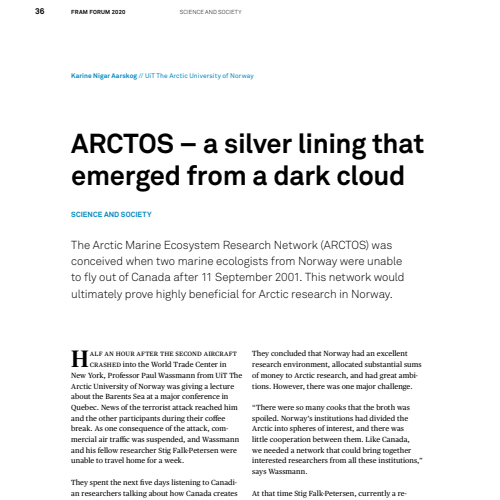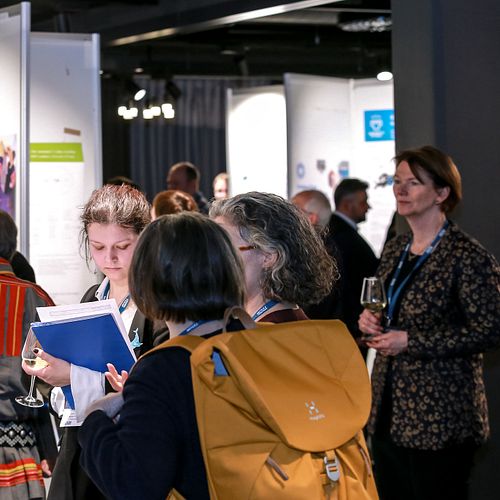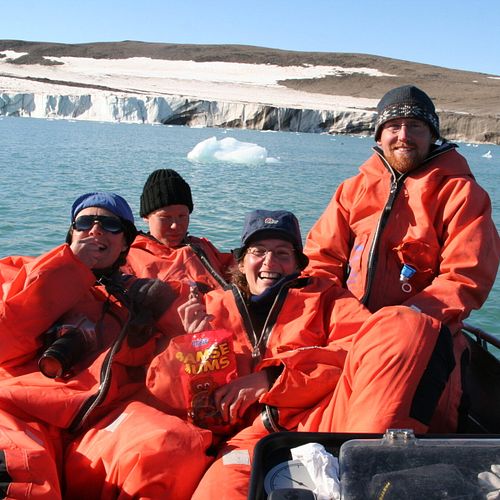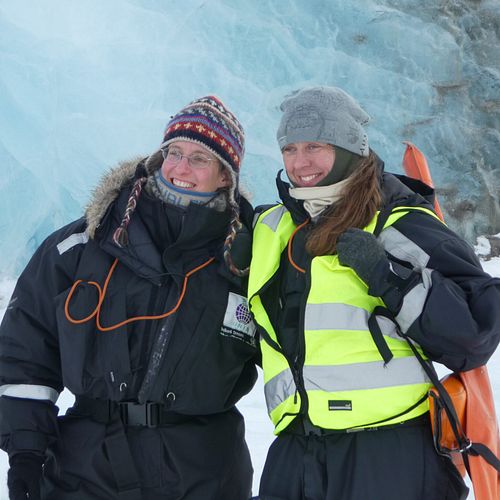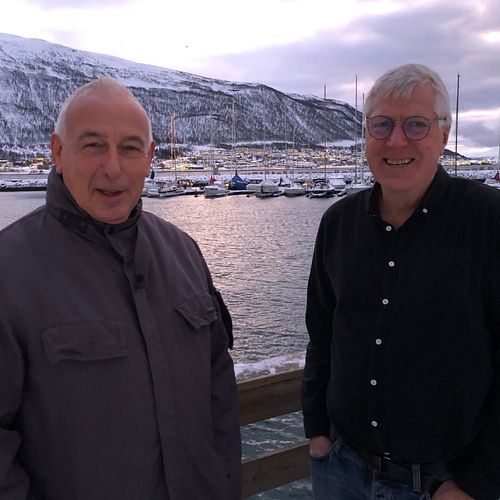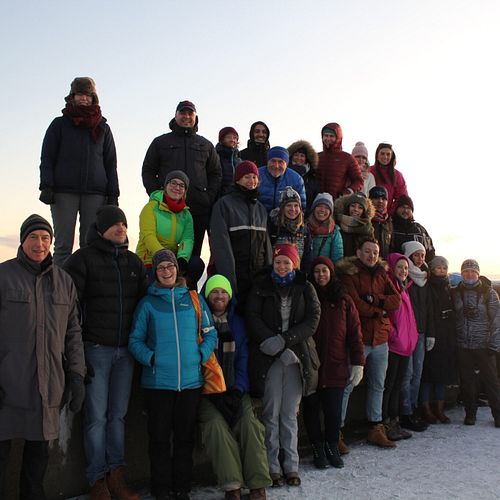10 June 2020 news
The Arctic Marine Ecosystem Research Network (ARCTOS) was conceived when two marine ecologists from Norway were unable to fly out of Canada after 11 September in 2001. This network would ultimately prove highly beneficial for Arctic research in Norway.
By: Karine Nigar Aarskog // UiT The Arctic University of Norway
Half an hour after the second aircraft crashed into the World Trade Center in New York, Professor Paul Wassmann from UiT The Arctic University of Norway was giving a lecture about the Barents Sea at a major conference in Quebec. News of the terrorist attack reached him and the other participants during their coffee break. As one consequence of the attack, commercial air traffic was suspended, and Wassmann and his fellow researcher Stig Falk-Petersen were unable to travel home for a week.
They spent the next five days listening to Canadian researchers talking about how Canada creates integrated, national research plans for the Arctic under the Canadian Arctic Shelf Exchange Study (CASES) research programme.
“This prompted us to think through Norway’s activities in the Arctic and ask ourselves if Norwegian research institutions could improve their cooperation and thus make an even better contribution to research on marine ecology in the High North,” says Wassmann.
They concluded that Norway had an excellent research environment, allocated substantial sums of money to Arctic research, and had great ambitions. However, there was one major challenge.
“There were so many cooks that the broth was spoiled. Norway’s institutions had divided the Arctic into spheres of interest, and there was little cooperation between them. Like Canada, we needed a network that could bring together interested researchers from all these institutions,” says Wassmann.
At that time Stig Falk-Petersen, currently a researcher at Akvaplan-niva, worked at the Norwegian Polar Institute. He says the conference revealed to him how little the researchers from other countries knew about the Arctic research being done in Tromsø.
“We had only ourselves to blame since no collaboration existed between our institutions in northern Norway. We had to do something about it,” says Falk-Petersen.
Closer collaboration
When Wassmann and Falk-Petersen finally returned to Tromsø, they contacted Salve Dahle, managing director of Akvaplan-niva, who was interested in cooperation.
“Obviously our network would need to have a purely academic research component, with emphasis on a research school and education for the next generation, along with links to environmental management. But it would also require an applied perspective: how can the research be of use to society, business and industry? This is where Akvaplan-niva came in. Having all the important dimensions right from the start was the key to ARCTOS success,” says Dahle.
One important goal was for our researchers to write more comprehensive applications and obtain more funding for larger research projects. During the two years following the establishment of ARCTOS in 2002, external grants for marine ecology research projects increased from 10 to 60 million Norwegian kroner.
“We agreed to write applications both jointly and in competition with each other. Those whose attempts to obtain funding were unsuccessful became involved as junior partners of those who received grants. This had a great impact,” says Falk-Petersen.
Since ARCTOS started up, the University Centre in Svalbard, the Norwegian Institute of Marine Research and Nord University have all joined the network. Today ARCTOS is run by Professor Jørgen Berge from UiT.
“We realised that Norwegian research in the Arctic had no clout, that it was fragmented and divided. If we want to be seen and have a stronger impact, we need to work together – and by doing that, we benefit each other. We’ve established many projects over the years,” says Berge.
 Eva Leu, Akvaplan-niva (left) and Janne Søreide, UNIS (Photo: Ulrike Grothe)
Eva Leu, Akvaplan-niva (left) and Janne Søreide, UNIS (Photo: Ulrike Grothe)Open network
At the heart of ARCTOS is the concept of having an altruistic network, open for anyone with a relevant professional interest. Among other things, this network has helped educate a new generation of researchers at its research school for PhD students.
Eva Leu, who is currently a senior researcher at Akvaplan-niva and a member of the ARCTOS Secretariat, has been involved in the network right from its inception. She was one of the first doctoral students to participate in the ARCTOS PhD School, which has so far educated a total of 55 PhD students. Leu says the network has been very important for her in her capacity as a researcher.
“The fact that I’ve become acquainted with other researchers through ARCTOS has been decisive for me in my scientific work. Attending the PhD School and getting involved in the network at an early stage in my career gave me a good start because I knew who I could contact later,” says Leu.
She believes that ARCTOS is particularly important for young researchers, who often go through a difficult phase between the end of their postdoc and their first permanent jobs as researchers.
“ARCTOS is a meeting place where new doctoral students can expand their horizons and get a clearer idea about current events in Arctic research. Being invited to attend meetings and activities through ARCTOS was what kept me alive. A network like this helps you through the best and worst aspects of scientific life,” she says.
According to Leu, one of the unique things about ARCTOS is its open, trusting atmosphere.
“This is thanks to the personalities of the founders of ARCTOS. They are good at sharing networks and bringing people together. I have tried to live up to this tradition and ask new, young researchers what I can do to help them,” says Leu.
Paul Wassmann says that he, Falk-Petersen and Dahle made use of their own networks to expand ARCTOS’ national and international networks.
“There are significant political and personal differences between us, but we all want to achieve something. Our own personalities and special interests should not be allowed to stand in the way of collaboration. We educated all the students and PhD fellows who joined the ARCTOS PhD School over the years. We found many practical solutions,” says Wassmann.
“When we merged our personal contacts, we had a network that included 30 international institutions,” adds Falk-Petersen.
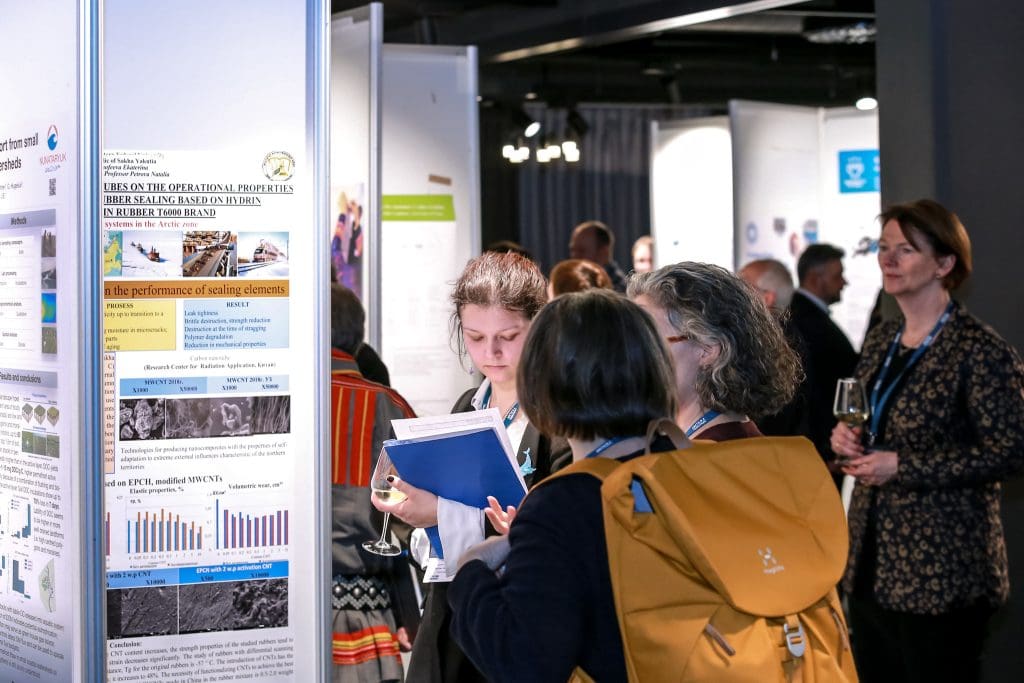 Arctic Frontiers 2020. Main poster session (Photo: Alberto Grohovaz/Arctic Frontiers).
Arctic Frontiers 2020. Main poster session (Photo: Alberto Grohovaz/Arctic Frontiers).Highly active
Eva Leu believes that ARCTOS has provided Norwegian Arctic research with precisely the sort of visibility that was required. The network can also take a lot of the credit for Tromsø’s annual international research conference, Arctic Frontiers.
The conference was held for the fourteenth time this year (2020) and has become an important meeting place to discuss research, industry, and politics. In connection with Arctic Frontiers, ARCTOS has been in charge of the Young Scientist Forum, which aims its activities at young researchers.
“Our PhD School and the Young Scientist Forum are probably the most important tools we currently have available to foster collaboration between marine ecologists in the institutions involved,” says Falk-Petersen.
ARCTOS also initiated the High North Academy programme for PhD students, which was taken over by UiT and is currently being run by the Faculty of Biosciences, Fisheries, and Economics. Since the network started, ARCTOS has worked actively on communicating with the general public, for example by arranging opportunities for journalists and artists to join expeditions.
“We have organised PolArt seven times in cooperation with the Tromsø Centre for Contemporary Art. Four artists have come along on expeditions each year over these seven years. We have also brought along musicians from Barcelona,” says Falk-Petersen.
Both Jørgen Berge and Paul Wassmann point out that, without ARCTOS, it would have been difficult to run large research projects such as the Nansen Legacy, and that such projects might not even have been initiated.
“The network is the ‘benevolent spirit’ who works behind the scenes without demanding much attention. The spirit behind ARCTOS is the same one who personifies the Nansen Legacy,” says Wassmann.
Jørgen Berge believes that ARCTOS has developed into a robust, viable network, and he describes the group as unique.
“ARCTOS is helping us all in the long term. We are working in the background and are keeping people together. Over time, many researchers have come to see the value of sticking together and collaborating, independently from their institutions,” says Berge.
Stronger together
Salve Dahle adds that the network has also acquired an important role as a knowledge base for researchers. Thanks to ARCTOS, they are always aware of the expertise and research resources available when discussing potential international cooperation.
“The fact that researchers know what they themselves and others in the network have to offer is one of the most important things about ARCTOS. Working together, we can achieve more than we would have done individually,” says Dahle.
Eva Leu can confirm this. She says she still derives great benefits from the network because she currently works in Oslo and does not have her Tromsø colleagues around her on a daily basis.
“ARCTOS has enabled me to engage in dialogues with international partners because I have a larger platform than I would have had if I was operating on my own,” says Eva Leu.
 ARCTOS postdocs and students enjoying summer field work in Rijfjorden, 2007 (Photo: Leif-Arild Håhjem)
ARCTOS postdocs and students enjoying summer field work in Rijfjorden, 2007 (Photo: Leif-Arild Håhjem)
Facts about ARCTOS:
- Seventy members from UiT The Arctic University of Norway, the Norwegian Polar Institute, Akvaplan-niva, the University Centre in Svalbard, the Norwegian Marine Research Institute and Nord University.
- Jørgen Berge (UiT) is the director, and Paul Renaud (Akvaplan-niva) is the deputy director.
- Has a secretariat and a board which represents its member institutions. Ulrike Grote is employed as the ARCTOS Secretary at UiT.
- The member institutions contribute NOK 30 000 each year.
- Each year, ARCTOS organises between four and six academic seminars with external lecturers, one PhD course in Lofoten, and ARCTOS Day on Sommarøy.
ARCTOS’ strategy sets the following goals for the next few years:
- Be a world-leading network for marine research connected to the marginal ice zone and other habitats unique to the Arctic
- Be recognised internationally for its excellence in Arctic marine ecosystem research, providing a holistic insight into the future ecosystem processes
- Become an international focal point for education, training, and integration across the pan-Arctic domain, and an important contributor of knowledge for environmental management of the Arctic
- Achieve a Centre of Excellence and one new National PhD School network
This article was produced for Fram Forum 2020. Fram Forum is published by Framsenteret AS on behalf of FRAM – the High North Research Centre for Climate and the Environment.

